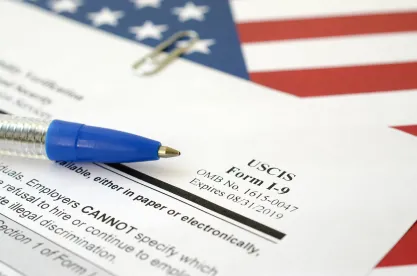On November 10, 2021, U.S. Citizenship and Immigration Services (USCIS) reached a settlement in the class action Shergill v. Mayorkas. As part of the settlement, USCIS agreed to update its policy relating to H-4 and L-2 spousal Employment Authorization Document (EAD) applications, and the settlement terms for H-4 and L-2 applicants have potential I-9 compliance implications for employers.
At the time of the settlement agreement, USCIS’s policy manual had not been updated to implement the terms related to H-4 and L-2 spousal work authorization. Several days after the lawsuit was settled, USCIS issued a policy alert further affirming the terms of the Shergill v Mayorkas settlement agreement. As of now, USCIS’s policy manual has been updated to include the settlement terms related to EAD applications for H-4 and L-2 applicants. While guidance related to H-4 spouses has not changed, there is an update for L-2 spouses who, pursuant to Shergill v. Mayorkas and the terms of the settlement agreement, would receive work authorization incident to L-2 status.
L-2 Spouses
L-2 spouses will be able to complete Form I-9 to verify ongoing employment authorization by presenting a combination of documents to their employers such as:
-
an expired EAD card indicating Category A18;
-
a Notice of Action (Form I-797C) for Form I-765 with the class requested in the same category as the expired EAD (A18 for L-2 spouses), and showing that the renewal application was filed before the EAD expired; and
-
an unexpired Form I-94 reflecting L-2 status.
The current process still requires L-2 spouses to properly and timely file their EAD applications (Form I-765) in order to obtain work authorization “incident to status.” In other words, at this moment in time, it is not enough for an L-2 spouse to hold valid L-2 status and be authorized to work pursuant to that status; a timely-filed EAD application is still required.
USCIS’s reasoning is that the only document issued to L-2 spouses that satisfies Form I-9 requirements is the EAD card itself. Currently, USCIS is in the process of developing an alternative form of documentation for L-2 spouses to “have immediate documentation of their employment authorization upon a grant of … L status.”
USCIS’s proffered solution is to work in conjunction with U.S. Customs and Border Protection (CBP) to modify the current Form I-94 so that it distinguishes employment-authorized L-2 spouses from dependent L-2 children, who are not eligible for work authorization. This modification has not yet been consistently implemented by USCIS and CBP; thus, L-2 spouses must continue to timely and properly file their EAD applications (Form I-765).
Additionally, even after Form I-94 is modified, L-2 spouses who choose to present their modified Form I-94 to employers will still be required to obtain separate identity documents in order to meet Form I-9 requirements.
Note that any such automatic extension of work authorization will terminate automatically on the earlier of:
-
the end of the validity period of H-4 or L-2 status, as shown on Form I-94;
-
the approval or denial of the application to renew the previous EAD card; or
-
180 days from the date of the expiration of the previous EAD card.
I-9 Implications for Employers
L-2 Spouses
In order to complete Form I-9 and verify ongoing employment authorization, L-2 spouses may present the following combination of documents to their employers, which document the 180-day automatic extension of work authorization:
-
an expired EAD card indicating Category A18;
-
a Notice of Action (Form I-797C) for Form I-765 with the Class requested in the same category as the expired EAD (A18 for L-2 spouses), and showing that the renewal application was filed before the EAD expired; and
-
an unexpired Form I-94 reflecting L-2 status.
Once USCIS and CBP modify the Form I-94, L-2 spouses may present the following combination of documents to their employers, which may document work authorization incident to L-2 status:
-
an unexpired Form I-94 reflecting employment authorization as an L-2 spouse; and
-
separate identity documents, which also meet Form I-9 requirements.




 />i
/>i

